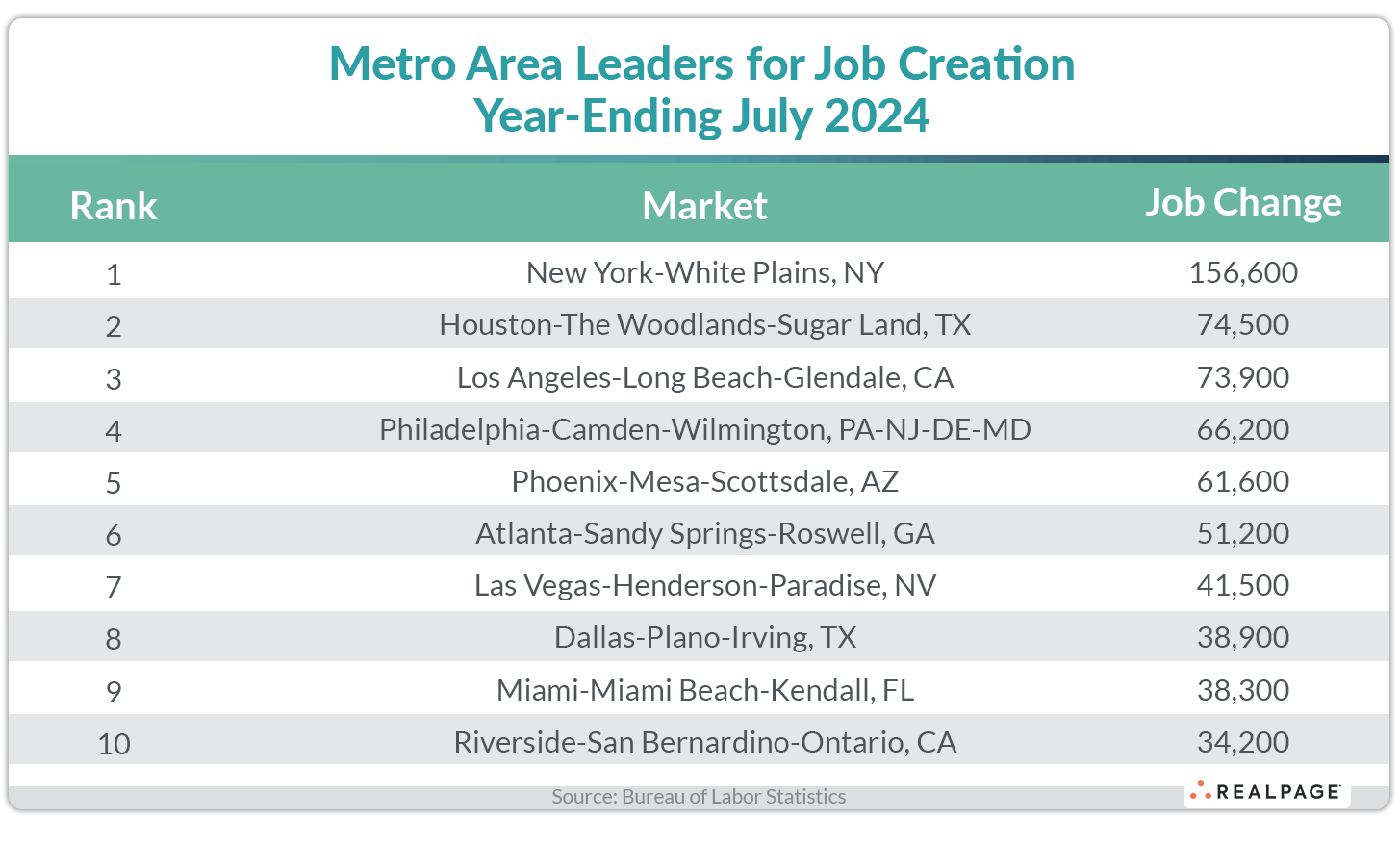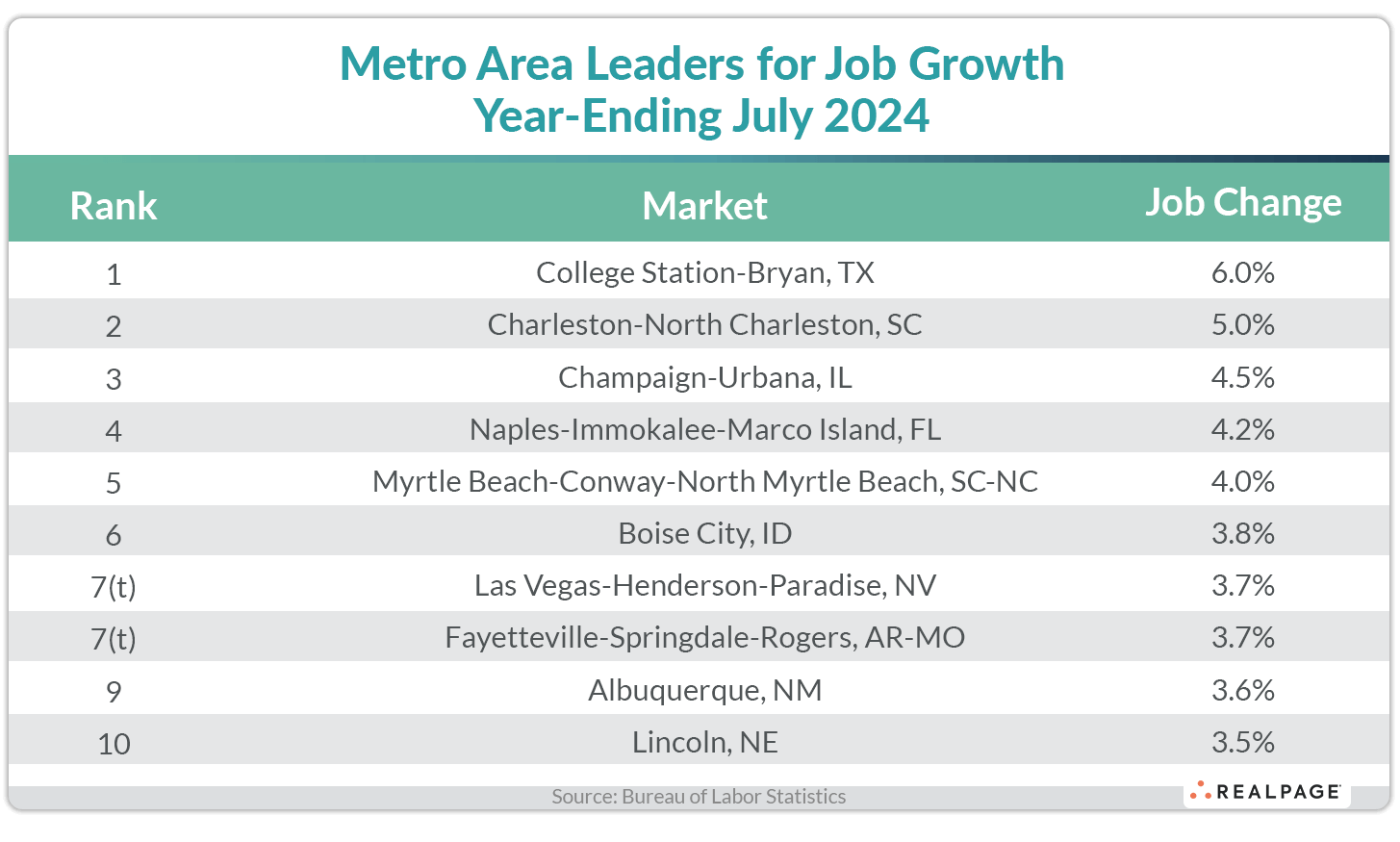The New York-White Plains metro division’s already strong annual employment gains enjoyed a sharp bump in July, bolstered by improvement in the Professional and Business Services and Trade, Transportation, and Utilities industries, but primarily benefiting from strong gains in the Education and Health Services industry.
According to data released by the Bureau of Labor Statistics, New York’s annual job gain for the year-ending July totaled 156,600 new workers, 60,400 more jobs than the upwardly revised 96,200 jobs through June. Six more top 10 job gain markets saw improvements in annual employment gains from last month.
Nine of June’s top 10 job creation markets returned in July with a few changing places.
New York’s strong July gains kept it in the #1 spot with the aforementioned 156,600 jobs gained for the year-ending July. Houston returned at #2 with a gain of 74,500 jobs through July, down 1,600 jobs from June’s total.
Los Angeles continues to see an improved economy with 73,900 new jobs, up 26,100 jobs from June, moving it up one spot to #3. Philadelphia fell back one spot to #4 with 66,200 jobs gained through July, an improvement of 8,900 jobs from last month’s annual gain. Phoenix remained in the #5 spot with 61,600 jobs gained, 8,900 jobs more than both last month and last year.
Atlanta jumped from #9 in June to #6 in July with an annual gain of 51,200 jobs, 13,500 jobs more than in June. Las Vegas also improved from June with a total of 41,500 new jobs through July, a bump of only 3,100 jobs, but enough to move Las Vegas up one spot to #7.
The Dallas metro division continues to cool, falling to #8 in July with a gain of 38,900 jobs, 5,100 fewer new jobs than in June and 42,100 less than July 2023. Right behind Dallas, Miami took the #9 spot with 38,300 new jobs, almost the same as in June and only 3,000 less than last July. Riverside replaced St. Louis at the #10 spot with an annual employment gain of 34,200 jobs, almost 5,000 more jobs gained than June’s total and more than 21,000 jobs greater than last July.
With the jump in New York and other top 10 markets, the total number of jobs gained for the year-ending July for the top 10 markets (636,900 jobs) was up 120,300 jobs or 23% from their collective total last month. The next 10 markets (#11-#20) saw their combined annual jobs gains increase by about 52,000 jobs.
Only New York exceeded 100,000 jobs gained for the year but five markets gained between 50,000 and 99,999 jobs, one more than last month. Eight markets reported annual job losses for the year, five less than last month. Major markets reporting annual job losses include Baltimore, Denver, Memphis and Milwaukee.
Like annual job gains, the annual percentage change in employment saw some improvement as well with nine markets increasing their employment growth rates from June. Only six of last month’s top employment growth markets returned in July and most changed places.
College Station, TX replaced Charleston, SC at #1 for job growth in July, jumping 200 basis points (bps) to 6% employment change. At #2, Charleston was almost unchanged from last month with 5% job growth, down just 10 bps and the only decliner among the top 10.
Landing at #3, Champaign-Urbana, IL was one of four newcomers to the top 10 job growth list with 4.5% growth, up 300 bps from last month. Naples, FL also joined the top 10 list at #4 with 4.2% employment growth, 120 bps better than June’s figure.
Myrtle Beach slipped a spot to #5, but its 4% job growth was 50 bps greater than in June. Boise came in at #6 with 3.8% growth, up 30 bps for the month. Las Vegas and Fayetteville, AR tied at #7 with 3.7% job growth and both were up 30-40 bps from June’s growth rates.
Newcomers Albuquerque and Lincoln rounded out the top 10 at #9 and #10 with growth rates of 3.6% and 3.5%, respectively. Each were up more than 100 bps apiece.
The top 10 employment growth markets still reflect areas with concentrations in tourism (Las Vegas and Myrtle Beach), state capitals (Lincoln and Boise) and/or major universities (College Station, Champaign-Urbana, Albuquerque and Fayetteville).
Compared to last year, only one market had a lower job growth rate and nine had higher rates. They ranged from an improvement of 350 bps in College Station to a decrease of 20 bps in Myrtle Beach.
Outside of the top growth markets, Stockton-Lodi, CA, Eugene, OR, Augusta, GA, San Francisco, Springfield, MA and Los Angeles saw their job growth rates increase by 200 bps or more from last year. Meanwhile, Midland/Odessa, Ann Arbor, MI, Corpus Christie, TX, Chattanooga, TN and Salisbury, MD fell by at least 300 bps from last year’s job growth.
As mentioned, major markets with employment declines are Baltimore, Memphis, Denver and Milwaukee. Sub-0.5% growth major markets include Portland, OR, Minneapolis-St. Paul, Chicago and San Francisco. Sub-1% growth major markets include San Jose, Detroit, Cleveland, Washington, DC, Cincinnati and San Diego. Eighty-six markets had annual job growth rates above the not seasonally adjusted national average of 1.6%, 10 more than in June.









